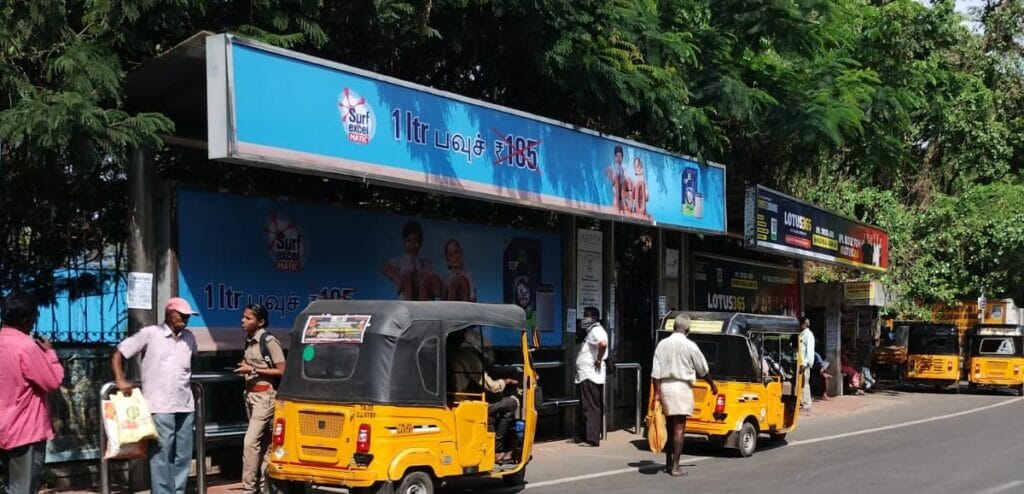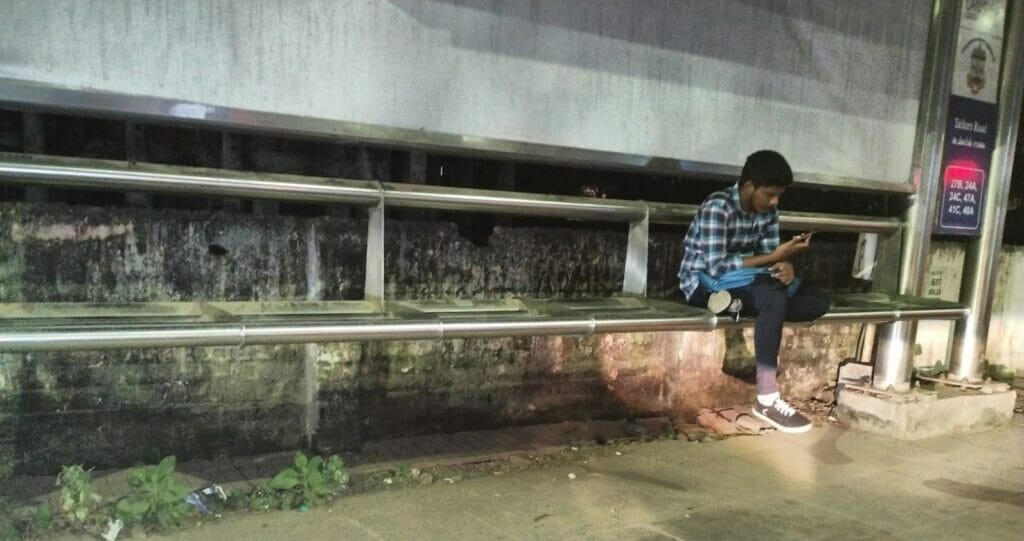An accessible, comfortable and functional bus shelter is an essential part of any urban mass transit system. Chennai’s bus shelters routinely fail to meet one or more of these parameters, affecting commuters.
From the perspective of the local administration, which is responsible for its management, a good bus shelter is one that has low maintenance requirements and is resistant to any form of vandalism. From the point of view of a commuter, an ideal shelter is one that allows visibility and easy access to the bus, is comfortable and convenient, provides clear information and is safe.
Both viewpoints are equally important to consider, as an unused bus shelter is a waste of taxpayers’ money and would still require regular maintenance.
A well-designed, comfortable shelter on the other hand can make waiting for the bus a pleasant experience for commuters and encourage more people to opt for public transport.
Read more: Why don’t we see electric buses on Chennai roads?
Comfort in bus shelters in Chennai
Bus shelters should ideally provide a proper place to sit, protection from the weather and a feeling of safety and security for commuters.
While driving through EVR Salai a couple of weeks ago, I noticed commuters waiting for buses at the bus shelter near the Taylors Road bus stop in Kilpauk. The seat at the bus shelter was fixed almost 3 to 3.5 feet off the floor. Commuters – especially women, children and senior citizens – had to jump to be able to sit on it.
Many opted to stand despite the presence of vacant seats as the seats were mounted at a height which is out of reach for the average commuter.
Previously, I had reported to the officials about a bus shelter located on Perambur High Road where the seat was almost level with the floor and footpath, forcing commuters to squat. It took over six months of follow-up to rectify the issue.
A few days ago, on a walk along Perambur High Road, I noticed the seats at the Jamalia Bus Shelter in a dilapidated condition. The stainless steel supporting frame of the seats was broken and many seats were missing. This bus shelter is located near the residence and office of the Mayor of Chennai.
A complaint has been lodged with the Greater Chennai Corporation (GCC) and action is awaited.

A proper template for the construction of bus shelters must be standardised across the city. Seats of the shelters must also not be fixed too low or too high. Other aspects such as space left on the footpath and the size of the overhead shade must also be fixed.
Shelters must also be modernised to keep up with changing times. Bus shelters are ideal for tapping into solar power. Such bus shelters have been operational across cities such as Kolkata, Lucknow, Mumbai and Varanasi.
Bus shelters can also be upgraded with public wifi systems that allow commuters to access information on the go.
The provision of small trash bins near bus shelters can help in keeping the neighbourhood litter-free. However, large trash bins are being placed right opposite bus shelters at many locations within Chennai. These bins are a source of discomfort for commuters waiting at the shelter and also pose health hazards.

In September 2021, our neighbourhood association in Perambur lodged a petition to remove the garbage transfer point located adjacent to the bus shelter near the CMWSSB Pumping Station on Perambur High Road. We had to repeatedly raise the matter with the local officials and escalate the matter to the Chief Minister’s Special Cell before the issue was resolved.
Read more: How does MTC decide bus routes in the city?
Safety in bus shelters in Chennai
Many bus shelters in Chennai are located in places that are desolate and do not see any foot traffic. Good locations for bus shelters are near small shops such as bakeries, flower shops and newsstands which are open late into the night, near office buildings within view of the security guards, near street vendors and in conjunction with other amenities such as public telephones, benches and so on.
The absence of any eyes on the street near bus shelters makes them unsafe for vulnerable groups such as women and discourages them from using public transport.
Lights in shelters should also be housed in a protective casing to reduce vandalism. They must be directed so that they illuminate the waiting and boarding areas.
Accessibility of bus shelters in Chennai
Accessibility is also a key issue in many bus shelters.
Bus riders and pedestrians have to crisscross each other as there is no dedicated setback area within the footpath for pedestrians near many bus shelters. Autorickshaws and share auto stands are also located along the bus bays making things very difficult for commuters.
Bus shelters located near the intersections should be set back from the crosswalk approximately 10 feet or more to avoid conflicts with pedestrian traffic. If the bus stop is on the far side of an intersection, the shelter should be located a minimum of 40 feet from the crosswalk to allow adequate room for the bus stop. For example, this is not the case when it comes to bus shelters located near the Perambur Railway Station.

Elements such as information kiosks or street vendors which obstruct the view of oncoming buses should be located “downstream” from the shelter. We get to see many shopkeepers and vendors putting up their stalls in a way that obstructs the commuters from boarding buses seamlessly.
Poorly designed shelters force commuters to step onto the roads to be able to spot the buses.
Lack of information on bus routes at bus shelters in Chennai
Confusion regarding where buses will stop is also widely prevalent across bus shelters in Chennai.
For example, there are two bus shelters marked as Perambur Railway Station – one is located on Perambur High Road and another on Madhavaram High Road. The total distance between these two shelters is only about 50 metres. The bus route numbers marked on the display boards are almost the same at both shelters. Even the locals find it very difficult to ascertain where they will have to stand in order to board a bus as not all buses stop at both shelters.
While there are bus shelters in one direction for outbound buses from Perambur to other destinations there are no bus shelters located in the opposite direction.
Some general guidelines should be followed in deciding whether or not a bus shelter is needed at a particular spot. Commuters must also be provided with information on when a bus will arrive and where it will go. This is especially very important for people who travel long distances or are unfamiliar with the bus services being operated in the city.
The above issues highlight the need for greater cooperation between the local administration, the transit department and any other parties involved in the maintenance and management of the bus shelters.
Periodic inspection of shelters must be made mandatory. Feedback from commuters must also be taken into account to make necessary adjustments.
If the difficulties faced by the commuters are considered, bus shelters across Chennai can be improved. This move would make using buses in the city a less harrowing experience.
